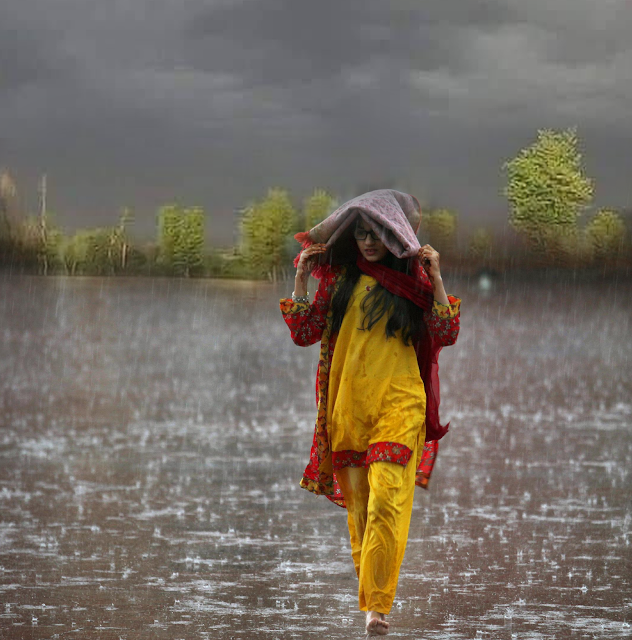 |
| Babiha Bambiha or Papiha |
Sri Guru Granth Sahib is a divine book that illustrates the love for God and His Creation. Twelve birds are mentioned in SGGS, some representing eternal love (Babiha, Chatrik), some singing eternal hymns (Koel, Bulbul), some dancing in divine ecstasy (Peacock), some depicting social calling (crow), some representing divine actions (Swan), and some indulging in anti-social activity (Crane, Herons and Hawks).
Babiha of Sri Guru Granth Sahib
Babiha represents the eternal love of the Soul for the God illustrated metaphorically as the rainbird's longing for the rain drops. Gurus observed singing present around nature and were enamored by the songs of birds and their affect on human emotions. In Sri Guru Granth Sahib, the following quote by Guru Amardas ji beautifully illustrates their love for the song birds:
slok mÚ 3 ] (Guru Amardas ji, Sri Guru granth sahib, Page1285)
bwbIhw AMimRq vylY boilAw qW dir suxI pukwr ]
The rainbird chirps in the ambrosial hours of the morning; its prayers are heard in the Court of the Lord.
myGY no Purmwnu hoAw vrshu ikrpw Dwir ]
The order is issued to the clouds, to let the rains of mercy shower down.
hau iqn kY bilhwrxY ijnI scu riKAw auir Dwir ]
I tender myself to those who enshrine the True Lord within their hearts.
nwnk nwmy sB hrIAwvlI gur kY sbid vIcwir ]1]
O Nanak, through the Name, all are rejuvenated, contemplating the Word of the Guru's Shabad. ||1||
The Shabad sung in the classic Raaga style by Padam Shri Bhai Nirmal Singh, Hazuri Raagi at Harmander Sahib:
Babiha in Barah Maha by Guru Nanak
In Barah Maha, the great Guru Nanak Dev ji beautifully describes human soul's love for God in terms of the twelve months. In the verse below, he describes the month of Bhadon after the Monsoon rains where snakes, mosquitos, and other distractions illustrate distractions that confuse the soul with doubts:
quKwrI CMq mhlw 1 bwrh mwhw (1Guru Nanak, Sri Guru Granth Sahib, Page 1108)
Bwdau Brim BulI Bir jobin pCuqwxI ]
In Bhaadon, the young woman is confused by doubt; later, she regrets and repents.
jl Ql nIir Bry brs ruqy rMgu mwxI ]
The lakes and fields are overflowing with water; the rainy season has come - the time to celebrate!
brsY inis kwlI ikau suKu bwlI dwdr mor lvMqy ]
In the dark of night it rains; how can the young bride find peace? The frogs and peacocks send out their noisy calls.
ipRau ipRau cvY bbIhw boly BuieAMgm iPrih fsMqy ]
"Pri-o! Pri-o! Beloved! Beloved!" cries the rainbird, while the snakes slither around, biting.
mCr fMg swier Br suBr ibnu hir ikau suKu pweIAY ]
The mosquitoes bite and sting, and the ponds are filled to overflowing; without the Lord, how can she find peace?
nwnk pUiC clau gur Apuny jh pRBu qh hI jweIAY ]10]
O Nanak, I will go and ask my Guru; wherever God is, there I will go. ||10||
The Mythical Rainbird
Babiha, Bambiha, Papiha are the names of the same bird, known as the common Hawk-Cuckoo (Hierococcyx varius). It is a medium-sized bird found primarily in the Indian subcontinent. It bears a close resemblance to the Shikra, the common Indian hawk, even in its style of flying and landing on a perch. This resemblance gives this group the generic name of Hawk-Cuckoo.
The common hawk-cuckoo is a medium- to large-sized bird, about the size of a pigeon (ca. 34 cm). The plumage is ashy grey above; whitish below, cross-barred with brown. The tail is broadly barred. The sexes are alike. They have a distinctive yellow eye ring.
Rainbird Song
Its a popular legend in Punjab if the Babiha (Hawk Cuckoo) is here then the monsoon cannot be far behind. Known as the harbinger of monsoons in the sub-continent, this migratory bird can be sighted in North India a few days before the onset of the Monsoon.
 |
| Monsoon in Rural Punjab |
During summer months, just before the monsoons, the males are easily detected by their repeated calls but can be difficult to spot. The call is a loud screaming three-note call, repeated 5 or 6 times, rising in crescendo and ending abruptly. It is heard frequently in early mornings and during the moonlit nights.
Guru Nanak's description of this birdsong as "Priyo-Priyo" more accurately illustrates the shrill singing of the hawk-cuckoo, found along the Himalayan foothills and Punjab.
Babiha in Punjabi Songs
References
The.Birds.and.Sri.Guru.Granth.Sahib.by.Sukhbir.Singh.Kapoor
Slok by Guru Amardas ji in Sri Guru Granth Sahib


Brilliant! Thank you so very much, Sardarji.
ReplyDeletePositive site, where did u come up with the information on this posting? I'm pleased I discovered it though, ill be checking back soon to find out what additional posts you include.By Click Downloader
ReplyDeleteMicrosoft Office
DisplayFusion Pro
GiliSoft Video Editor
Tenorshare UltData Windows